There’s something seriously scary about video games in the horror genre. Unlike a movie, where you ultimately know that no matter what happens, you’re not really involved in the action, video games force you to live through every jump scare as if you were really experiencing it.
This immersive quality is part of what made Red Hook’s Darkest Dungeon video game so notorious (in a good way, of course). It’s just so damn terrifying. And now, you’ll be pleased – and a little scared – to hear that there’s a board game version of Darkest Dungeon available too.
Only the bravest of players will make it to the end to successfully uproot evil in the Darkest Dungeon. I nearly didn’t!
Death isn’t even the worst fate in this cooperative strategy game of dark and twisted evil. In fact, by the end, you might just be praying for it…
Darkest Dungeon: a Quick Overview
- Players – 1-4
- Recommended age – 14+
- Playing time – 90-120 minutes
Darkest Dungeon is a campaign board game in which players work cooperatively to rid a manor house and its surroundings (classic horror setting, I know, but you’ve got to love it) of all types of evil, from grotesque beasts to hordes of zombies.
Along the way, characters can grow mad or become deranged from the horrors they have to endure. It’s one of the most intense games I’ve ever played, that’s for sure!
Aim of the Game
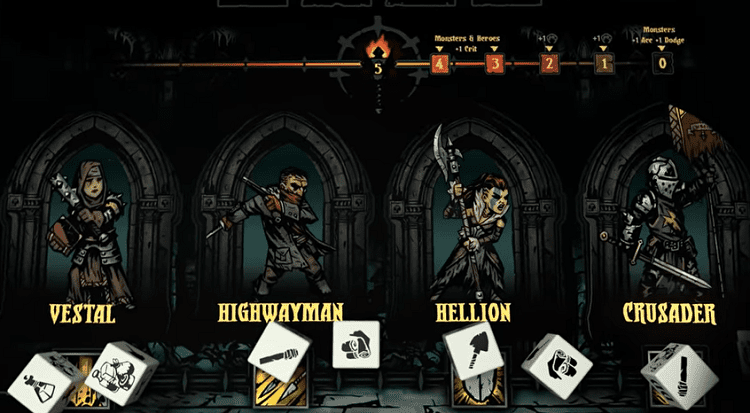
The campaign game progresses over four acts with eleven episodes in total. If players manage to survive all episodes, they win!
How to Play
Here’s how to play the Darkest Dungeon board game:
Setup
The first step of setting up the game involves randomly selecting a Boss card, which determines the primary antagonist of the campaign.
The antagonist has three levels of threat, and until confronted, their passive abilities will impact the game in both the hamlet and the dungeon. Set the card down somewhere near the board.
Next, each player must choose a hero, collecting the matching hero board. Pick three level one skills from the heroes skill card deck and put them in the correct slot on the board.
Take a stress meter token and place it white side up on the zero space of your stress track.
Hero boards include:
- A hero level (make sure you start on the level one side)
- Hero name
- Dodge
- Life total
- Resistances
- Immunities
- A town ability
- A death’s door die slot
- A stress track
- Skill slots which range from levels one to three
- Placement slots for trinkets, diseases, and quirks
Choose two additional heroes to remain on the side area of the game, known as the stagecoach. These heroes will be in the hamlet waiting to take over if someone else dies or cannot continue.
If all heroes die, or less than four heroes remain at the beginning of an episode, the game is lost.
After characters have been established, take out the stance trackers. Put the corresponding hero cards on the hero’s stance track. Stances include:
- Aggressive
- Defensive
- Range
- Support
Create a supply of decks that have been shuffled separately, including:
- Afflictions
- Diseases
- Virtues
- Quirks (negative and positive)
- Curios and trinkets
- Room cards
- Monster cards
- Town event cards
Then, create a supply of tokens separated by type and set the light tracker on five.
Shuffle the quest deck and randomly draw two level one quests. Pick one quest to play for this game and discard the other.
Quest cards have an objective and XP award, allowing heroes to level up between dungeon runs.
Follow the instructions on the quest card and gather the required room tiles.
After this, it’s time to set up the dungeon layout. Do this by randomly drawing a dungeon board map and positioning the room tiles randomly, face down in the room slots.
Place the party figure on the start location.
Now you’ll need to roll for provisions. Take turns rolling the two provision dice. A wild symbol allows you to turn the dice to any desired side.
Once this is done, all dice are put aside in a shared pool. They can be used throughout the game for their face-up ability, which includes things like:
- Bandages for healing
- Food for hunger
- Tools to counter exploration hazards
- Torch for light
- Potion for stress
Gameplay
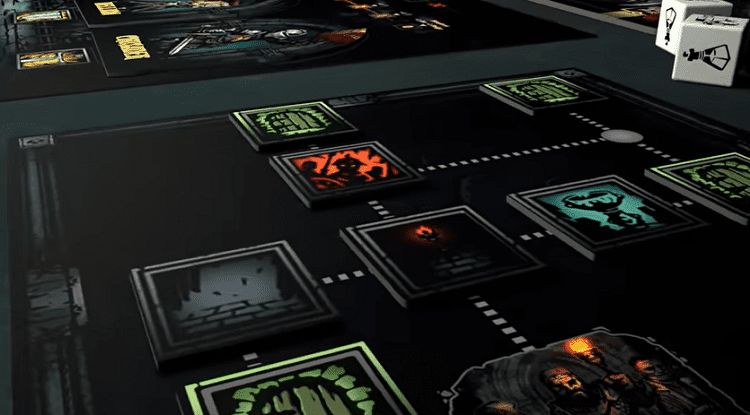
Gameplay progresses in shared turns. First of all, the party navigates through the dark and dingy corridors of the dungeon, exploring different rooms so they can complete their quest.
There are three steps the players can choose to take:
- Scout (this is optional)
- Explore
- Enter a room
Scouting
If everyone in the group agrees to go ahead with the first step, the party scouts ahead, revealing the rooms adjacent to the room they are currently in.
Along the corridors, you’ll notice dotted lines – these represent long hallways and, when next to rooms, are considered the adjacent spaces.
Scouting results in each hero suffering one stress, so players need to move their stress tokens along the track.
Exploring
Exploration comes next. The group should take this opportunity to discuss the strategies and tactics they want to use going forward.
During this stage, characters can change stances and consume any provisions.
Turn order during exploration is determined by stance; the aggressive player goes first.
Once the group has decided which path to take, each player rolls two exploration dice (if they scouted, they only roll one) and resolves their rolls. Results may include:
- Stressful darkness – spend one torch provision or produce light by one or suffer two stress
- Rubble – spend one tool provision to remove or suffer one damage per hero level and one stress
- Curio – draw a Curio card to see what object of interest you have found (spend one torch provision before you draw to ignore any adverse effects of the Curio)
During this stage of the game, if players walk back through a corridor they have already explored, they suffer one stress.
Entering a Room
After the exploration results have been resolved, players enter the room. What happens next depends on the type of room it is.
Traps
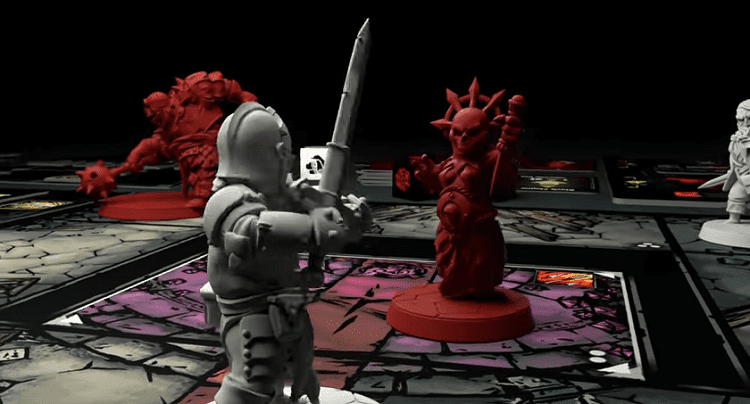
Some rooms are empty (phew, you can relax for a few minutes!), while others have traps that cause each hero to suffer a total of stress and/or damage equal to the dungeon level. The amount can be divided between stress and damage in whichever way a player chooses.
Unfortunately, traps stay in place; there’s no way of clearing them.
Dark Rooms
Dark rooms reduce the total light by one point. Don’t remove the token even after it has been resolved. Like rooms with traps, dark rooms are impossible to clear.
Lair
Now you’ll need nerves made of steel. I’m talking, of course, about rooms with lairs that are full of terrifying monsters!
Enter a room with a lair, and there’s no time to prepare – you have to initiate battle straight away.
If the heroes are victorious, the room has been cleared so you can remove the token.
Curio
You’ll find a Curio – also known as an object of interest – in the center of the room. Often, these rooms are guarded by monsters.
Roll a d10, and initiate battle if you roll 1-5. Rolling 6-10 means that the room is cleared, and you can remove the token from the board.
Once the room has been cleared, draw a Curio card to determine which player interacts with the object.
Treasure
Some rooms contain treasure that is guarded by monsters. Yes, you’ve guessed it, it’s time for another battle…I told you this game is intense.
When the room is cleared, you gain 20 gold and, as ever, remove the token from the board.
Objective
These are the most important rooms. Certain quests have objective rooms, so you’ll need to consult the Quest card to find out what happens.
Usually, rooms of this kind are specific dungeon rooms. It’s a good idea to set these rooms aside when you initiate your quest so you won’t risk encountering them in random battles.
Objective rooms are guarded by monsters (of course), so you’ll need to do battle first.
Quests
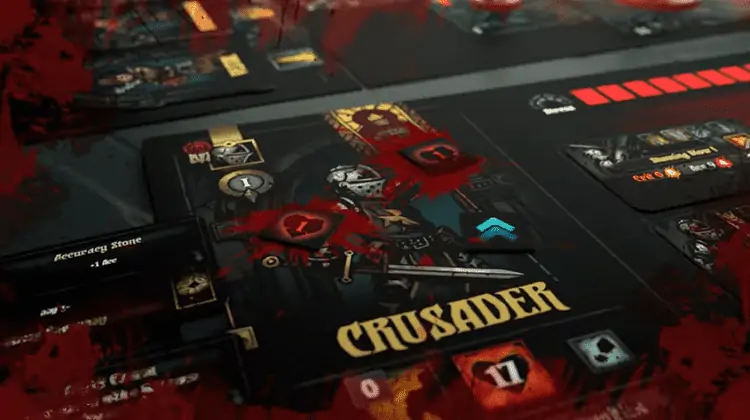
Some quests provide campfire supplies that can be used to allow players to rest after a room has been cleared. Rest points can be distributed amongst players to recover stress and/or life.
Gold is a shared resource that can sometimes be found during quests. It goes into a pool near the provisions and will be spent in the hamlet once the dungeon is complete.
Battles
Now for the exciting part! First of all, you’ll need to reveal a room card and put its corresponding room tile in the middle of the table.
If the room has special effects, you should read these out loud, so everyone in the group is aware of them. Once this has been done, put the hero models in the space that matches their stance.
Start drawing monsters from the monster deck, positioning them on the monster stance tracker until all four spaces are filled. If they’re aggressive, they go at the front. Place the monster figures on the board.
Large monsters might occupy multiple stances, reducing the overall number of monsters in battle.
Move the round tracker to round one, then place a loot tracker token face down in areas with an exclamation point. Now you’re ready to do battle!
Firstly, reveal an initiative card (this will have either heroes or monsters on the face-up side). The left-most character who has not yet been activated takes their turn.
Hero Turns
Heroes can perform two actions from the following during their turn:
- Move as many areas up to their speed as they’d like
- Change stance, moving up or down a space on the stance track
- Interact (e.g., pick up loot or engage with quest items)
- Use a skill
To use a skill, the hero must be in the correct stance and range and indicate their target. Once this has been established, they roll a ten-sided die, and if the result is less than their accuracy rating minus the dodge value of a hostile target, they hit.
The skills power either inflicts wounds or has other game effects.
Some skills can also apply conditions to a character. These include bleeding, buffs, and blight.
Monster Turns

Resolve monster actions in this order:
- Based on the stance it is currently on, select the ability marked with a number (for monsters with more than one skill, roll a d10 to decide which is used)
- Choose the target (I’d recommend prioritizing based on stance)
- If no targets are within range, the monster alters its move speed to get into range
- Take action
After all monsters and heroes have taken their turn, the battle round ends. Move the tracker up one space.
If, after four rounds, the room has not been cleared of monsters, the party has to leave without removing the tile from the map. However, if they successfully clear the monsters, the tile can be removed. Hooray!
Other Game Effects
The illumination of the dungeon changes depending on different game effects, and specific penalties may apply, including:
- High critical chances
- Extra stress
- Bonus dodge and accuracy points for the monsters
When a hero reaches zero life, they enter a state called “at death’s door.” Instead of taking wounds, they roll the “at death’s door” die for each wound they suffer. If they roll a skull icon, the hero dies.
Gaining just one life point is enough to bring a hero back from death’s door, meaning they are no longer at significant risk.
XP can be acquired by finishing quests and adding them to the stagecoach counter. By visiting the guild in the hamlet, players can use these points to buy new skills.
End of the Game
It all comes to an end in the Darkest Dungeon, which only the bravest and strongest heroes will reach. Defeat the ultimate source of evil by following the steps above, and you will be victorious!
Who is Darkest Dungeon for?
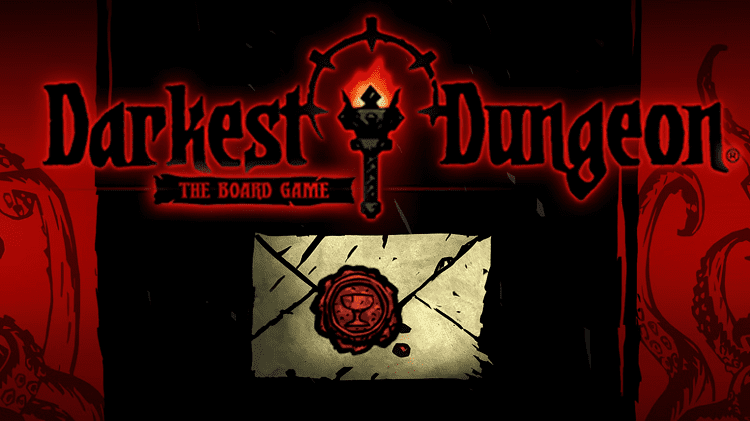
Darkest Dungeon is a role-playing game recommended for one to four players aged fourteen and above. However, due to the game’s dark themes, I’d suggest this age should be slightly higher.
The game is funded through Kickstarter, primarily by avid fans of the original videogame. Still, there’s no reason someone who isn’t already familiar with Darkest Dungeon wouldn’t enjoy playing as well. There’s a great story to get your teeth into, and you can easily pick it up as you go along.
If you don’t like the horror genre, it’s probably a good idea to steer clear of Darkest Dungeon, but strategy game fans will find plenty to enjoy.
How many Pieces are there in Darkest Dungeon?
In the core game, you will find:
- 1x rulebook
- 72x miniatures (8 hero miniatures, 64 monster miniatures)
- 32x dice (8 exploration dice, 16 provision dice, 4 death’s door dice, and 4 d10 dice)
- 12x double-sided room tiles
- 16x hero boards
- 4x skill boards
- 1x hamlet board
- 3x main dashboards
- 10+ dungeon cards
- 400+ cards (tarot cards for monsters; poker cards for Curios, hamlet events, and rooms; mini euro cards for trinkets, quirks, and skills)
- 200+ various tokens
Alternatives to Darkest Dungeon
Below, I’ve included some other games I’d recommend.
Specter Ops
Like Darkest Dungeon, Specter Ops combines tactical complexity with a compelling premise. Players aim to capture a mysterious agent who has infiltrated a top secret Raxxon facility. The only options are to hunt or be hunted – it’s very tense!
In our complete game guide, you can learn more about why Specter Ops is a fantastic sci-fi game.
- Players – 2-5
- Recommended age – 13+
- Playing time – 60-120 minutes
13 Dead End Drive
Not sure you can handle the horrors that await you in Darkest Dungeon? Totally understandable.
13 Dead End Drive is another game that focuses on a creepy location (in this case, a manor house), but rather than trying to free it from monsters, you’re trying to release it (along with the rest of your rightful inheritance) from several other possible heirs.
Basically, someone needs to inherit Aunt Agatha’s fortune, and you’ll do whatever it takes to make sure it’s you!
Read more about 13 Dead End Drive in our guide.
- Players – 2-4
- Recommended age – 9+
- Playing time – 45 minutes
Frequently Asked Questions
Question: Where Can I Buy Darkest Dungeon?
Answer: You can make a pledge on Kickstarter to receive a copy of the game.
Question: How many Areas are in the Darkest Dungeon?
Answer: There are four quests altogether, all at the Darkest level. Complete them to win the game.
Question: What Languages is Darkest Dungeon Available in?
Answer: English, Spanish, French, German, and Italian.
Question: Can I Really Play Darkest Dungeon Solo?
Answer: Yes, you really can! It’s a lot more fun with friends, though. But if you enjoy going it alone rather than playing as part of a team, check out our guide to the best solo board games.
Question: Is Darkest Dungeon a Family Game?
Answer: In a word: no. It isn’t the sort of game that would go down well with family members if you arranged a game with everyone from granny to your four-year-old niece. It’s scary, and, well, that’s the point.
Nevertheless, we have a guide to the best family board games, which you might find helpful.
Recommended reads:
- Stratego Pieces Explained – Must-Know Facts - February 28, 2023
- Wahoo Board Game Guide – AKA Aggravation Guide - February 22, 2023
- Pokemon Monopoly Guide - February 22, 2023



